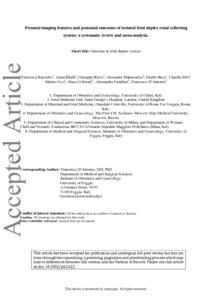Bascietto, F; Khalil, A; Rizzo, G; Makatsariya, A; Buca, D; Silvi, C; Ucci, M; Liberati, M; Familiari, A; D'Antonio, F
(2020)
Prenatal imaging features and postnatal outcomes of isolated fetal duplex renal collecting system: a systematic review and meta-analysis.
Prenat Diagn, 40 (4).
pp. 424-431.
ISSN 1097-0223
https://doi.org/10.1002/pd.5622
SGUL Authors: Khalil, Asma
![[img]](https://openaccess.sgul.ac.uk/111530/1.hassmallThumbnailVersion/Bascietto_et_al-2019-Prenatal_Diagnosis.pdf)  Preview |
|
PDF
Accepted Version
Available under License ["licenses_description_publisher" not defined].
Download (2MB)
| Preview
|
Abstract
OBJECTIVES: To perform a systematic review of studies reporting the outcome of fetuses with a prenatal diagnosis of isolated duplex collecting system (DCS). METHODS: Inclusion criteria were studies reporting the outcome of fetuses with a prenatal diagnosis of isolated DCS, defined as DCS not associated with other major structural anomalies at the time of diagnosis. The outcomes observed were: imaging features of DCS on prenatal ultrasound, associated anomalies detected exclusively at prenatal follow-up ultrasound and at birth, abnormal karyotype, symptoms at birth [including vesicoureteral reflux (VUR), urinary tract infections (UTI)], need for and type of surgical approach, complications after surgery and accuracy of prenatal ultrasound in correctly identifying this anomaly. RESULTS: Eleven studies (284 fetuses with a prenatal diagnosis of DCS) were included. On ultrasound, DCS was associated with ureterocele in 70.7% and with megaureter in 36.6% of cases. Worsening of pelvic/ureteric dilatation was reported to occur in 41.3% of fetuses. At birth, 4.3% of fetuses affected by DCS showed associated renal anomalies. After birth, VUR and UTI presented in 51.3% and 21.7% of children respectively, while 33.6% required surgery. Prenatal diagnosis of DCS was confirmed in 90.9% of included cases. CONCLUSION: DCS diagnosed prenatally is associated with a generally good outcome. Prenatal ultrasound has a good diagnostic accuracy, while detailed post-natal assessment is required in order to identify associated renal anomalies. This article is protected by copyright. All rights reserved.
Statistics
Item downloaded times since 03 Jan 2020.
Actions (login required)
 |
Edit Item |



